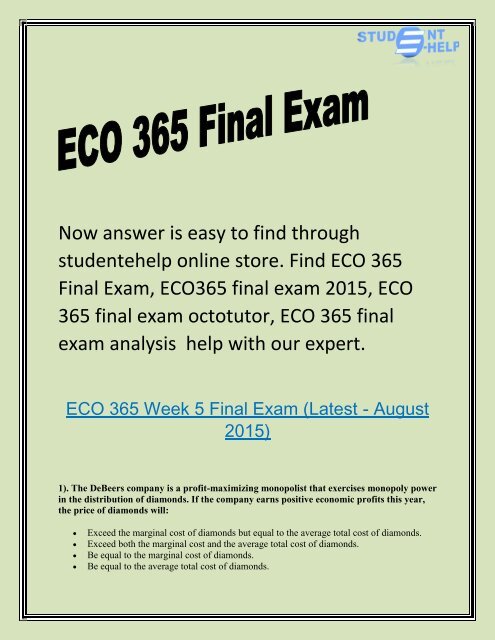ECO 365 Final Exam - ECO 365 final exam octotutor : Studentehelp
Now you can find online help through Studentehelp online education tutorial. Here you find best answer, solved paper, regarding ECO 365 Final Exam, ECO 365 final exam 2015, eco 365 final exam analysis. http://www.studentehelp.com/university-of-phoenix/ECO-365.html
Now you can find online help through Studentehelp online education tutorial. Here you find best answer, solved paper, regarding ECO 365 Final Exam, ECO 365 final exam 2015, eco 365 final exam analysis.
http://www.studentehelp.com/university-of-phoenix/ECO-365.html
Create successful ePaper yourself
Turn your PDF publications into a flip-book with our unique Google optimized e-Paper software.
Now answer is easy to find through<br />
studentehelp online store. Find <strong>ECO</strong> <strong>365</strong><br />
<strong>Final</strong> <strong>Exam</strong>, <strong>ECO</strong><strong>365</strong> <strong>final</strong> <strong>exam</strong> 2015, <strong>ECO</strong><br />
<strong>365</strong> <strong>final</strong> <strong>exam</strong> <strong>octotutor</strong>, <strong>ECO</strong> <strong>365</strong> <strong>final</strong><br />
<strong>exam</strong> analysis help with our expert.<br />
<strong>ECO</strong> <strong>365</strong> Week 5 <strong>Final</strong> <strong>Exam</strong> (Latest - August<br />
2015)<br />
1). The DeBeers company is a profit-maximizing monopolist that exercises monopoly power<br />
in the distribution of diamonds. If the company earns positive economic profits this year,<br />
the price of diamonds will:<br />
<br />
<br />
<br />
<br />
Exceed the marginal cost of diamonds but equal to the average total cost of diamonds.<br />
Exceed both the marginal cost and the average total cost of diamonds.<br />
Be equal to the marginal cost of diamonds.<br />
Be equal to the average total cost of diamonds.
2). Using 100 workers and 10 machines, a firm can produce 10,000 units of output; using<br />
250 workers and 25 machines, the firm produces 21,000 units of output. These facts are<br />
best explained by:<br />
<br />
<br />
<br />
<br />
Economies of scope<br />
Diseconomies of scale<br />
Diminishing marginal productivity<br />
Economies of scale<br />
3). Suppose that college tuition is higher this year than last and that more students are<br />
enrolled in college this year than last year. Based on this information, we can best conclude<br />
that:<br />
<br />
<br />
<br />
<br />
despite the increase in price, quantity demanded rose due to some other factors changing.<br />
the demand for a college education is positively sloped.<br />
the law of demand is invalid.<br />
this situation has nothing to do with the law of demand.<br />
4). A monopoly firm is different from a perfectly competitive firm in that:<br />
<br />
<br />
<br />
<br />
A monopolist’s demand curve is perfectly inelastic whereas a perfectly competitive<br />
firm’s demand curve is perfectly elastic.<br />
A competitive firm has a u-shaped average cost curve whereas a monopolist does not.<br />
A monopolist can influence market price whereas a perfectly competitive firm cannot.<br />
There are many substitutes for a monopolist’s product whereas there are no substitutes<br />
for a competitive firm’s product.<br />
5). The best <strong>exam</strong>ple of positive externality is:<br />
<br />
<br />
<br />
<br />
Alcoholic beverages<br />
Pollution<br />
Education<br />
Roller coaster rides<br />
6). The theory that quantity supplied and price are positively related, other things constant,<br />
is referred to as the law of:
supply<br />
profit maximization<br />
opportunity cost<br />
demand<br />
7). A reduction in the supply of labor will cause wages to:<br />
<br />
<br />
<br />
<br />
Decrease and employment to decrease.<br />
Increase and employment to increase.<br />
Decrease and employment to increase.<br />
Increase and employment to decrease.<br />
8). Other things held constant in a competitive labor market, if workers negotiate a<br />
contract in which the employer agrees to pay an hourly of $17.85 while the market<br />
equilibrium hour rate is $16.50, the:<br />
Quantity of workers demanded will exceed the quantity of workers supplied.<br />
Quantity of workers supplied will exceed the quantity of workers demanded.<br />
Supply of labor will decrease until the equilibrium wage rate is $17.85.<br />
Demand for labor will increase until the equilibrium wage rate is $17.85.<br />
9). Alex is playing his music at full volume in his dorm room. The other people living on his<br />
floor found this to be a nuisance, but Alex doesn’t care. Alex’s music playing is an <strong>exam</strong>ple<br />
of:<br />
<br />
<br />
<br />
<br />
Pareto externality<br />
Positive externality<br />
Negative externality<br />
Normative externality<br />
10). Oligopoly is probably the best market for technological change because:<br />
<br />
<br />
The typical oligopoly has the funds to carry out research and development and believe<br />
that its competitors are innovating, which motivates it to conduct research and<br />
development.<br />
The typical oligopoly lacks the funds to carry out research and development and therefore<br />
will use basic research from universities.
Research and development occurs only if government subsidizes<br />
such activity, and government tends to subsidize oligopolies.<br />
The typical oligopoly keeps price very close to average total cost because it fears the<br />
entry of new rivals if its profits are excessively high.<br />
11). A perfectly competitive firm facing a price of $50 decides to produce 500 widgets. Its<br />
marginal cost of producing the last widget is $50. If the firm’s goal is to maximize profit, it<br />
should:<br />
<br />
<br />
<br />
<br />
Produce more widgets<br />
Produce fewer widgets<br />
Continue producing 500 widgets<br />
Shut down<br />
12). Graphically, a change in price causes:<br />
<br />
<br />
<br />
<br />
the demand curve to shift.<br />
both supply and demand to shift.<br />
a movement along a given supply curve, not a shift.<br />
the supply curve to shift.<br />
13). In 1997, the federal government reinstated a 10 percent excise tax on airline tickets.<br />
The industry tried to pass on the full 10 percent ticket tax to consumers but was able to<br />
boost fares by only 4 percent. From this you can conclude that the:<br />
<br />
<br />
<br />
<br />
Supply of airline tickets is perfectly inelastic.<br />
Supply elasticity of airline tickets is less than infinity.<br />
Demand elasticity for airline tickets is greater than zero in absolute value.<br />
Demand for airline tickets is perfectly inelastic.<br />
14). In 2011, the Department of Justice sued AT&T to block its merger with the cell phone<br />
service provider T-Mobile. To defend itself against the charge, AT&T argued that the:<br />
<br />
<br />
<br />
<br />
Combined company could raise prices, allowing it to survive in a rapidly changing<br />
market.<br />
Government had no authority to block mergers in the telephone industry.<br />
Government had guaranteed it exclusive control of cell phone service.<br />
Merger would improve and expand cellular service to consumers.
15). The law of diminishing marginal productivity implies that the marginal product of a<br />
variable input:<br />
<br />
<br />
<br />
<br />
Never declines<br />
Always declines<br />
Is constant<br />
Eventually declines<br />
<strong>ECO</strong> <strong>365</strong> Week 1 Knowledge Check | <strong>ECO</strong> <strong>365</strong> Week 2<br />
Knowledge Check | <strong>ECO</strong> <strong>365</strong> Week 3 Knowledge Check |<br />
<strong>ECO</strong> <strong>365</strong> Week 4 Knowledge Check | <strong>ECO</strong> <strong>365</strong> Week 5<br />
Knowledge Check | <strong>ECO</strong> <strong>365</strong> Week 5 <strong>Final</strong> <strong>Exam</strong><br />
Click below link for more information:<br />
<strong>ECO</strong> <strong>365</strong> <strong>Final</strong> <strong>Exam</strong><br />
<strong>ECO</strong> 372 <strong>Final</strong> <strong>Exam</strong><br />
<strong>ECO</strong> 561 <strong>Final</strong> <strong>Exam</strong><br />
LAW 421 <strong>Final</strong> <strong>Exam</strong><br />
For more information click: http://www.studentehelp.com
















